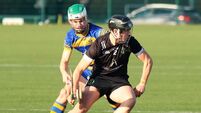Today’s ‘misunderstood’ teenagers are no different from predecessors
This weekend, police in America released for public consumption a thousand pages of previously unpublished writings by two mass murderers.
The killers — Eric Harris and Dylan Klebold — were the teenagers who opened fire on their fellow students, killing 13 at the Columbine High School a few years ago. The writings include diary entries, homework and personal computer notes.
The move has been welcomed in the belief that it will help prevent similar atrocities in the future because the chilling insights into the killers’ mindset provided by publication will allow parents, teachers or the authorities to head future teenage killers off at the pass.
This is complete and dangerous nonsense.
The essays show precisely what compositions by disaffected male teenagers nearly always show: an obsession with guns, the Third Reich and Charles Manson.
Which begs the question: is every unpopular young male pupil who includes references in his essays to Hitler, the Helter Skelter murders or “blowing people away” to be taken into protective custody and force-fed counselling in order to psychologically vaccinate him against the future possibility of spree-killing his classmates?
Even if that were remotely possible, individuals like Harris and Klebold would quickly learn to keep the subject-matter of their essays away from topics which might be identified by their teachers as indicative of lethal intent.
Of course, families of some of those who were shot in Columbine would point out that the bulk of the planning for the killings didn’t turn up in homework, but was available on the computers owned by the two and should have been discovered before the massacre happened.
It certainly COULD have been discovered. Any such material could be discovered, if all parents decided that teenagers have no right to privacy. If parents plough at will through diaries and other private writings, they undoubtedly can “out” their children for having all sorts of evil thoughts and plans. In the process, of course, the parents will make it clear to their own children (at least) that Parents Rule and teenagers are powerless and disrespected.
It’s difficult to think of a better way to generate violent disaffection among young people. (Fortunately, few parents who would want to so invade their children’s privacy and even fewer would have the computer-competence to do it effectively).
Moreover, those in the prevention brigade who would ride roughshod over the right to privacy of teenagers in order to thwart school murders rather miss the apple-doesn’t-fall-far-from-the-tree point. Some parents, finding their children’s diaries to be full of hatred and contempt for fellow students and for teachers, would happily buy into that hatred and contempt.
For example, the material published this weekend includes a pre-massacre note from the father of one of the Columbine killers, in which he utterly rejects charges that his son has bullied another pupil, describing the other kid as “a manipulative con artist.”
Gun-worshipping parents who hate their neighbours are unlikely to get worked up if they find their offspring day-dreaming about spectacular ways of flattening a few of those neighbours.
The well-meaning who applauded the release of the documentation not only hold the questionable view that all sharing of all information is somehow societally virtuous, but make a daft leap in logic while they’re at it. That’s believing information equals prevention. It doesn’t.
Tell your girlfriend the guy she fancies is superficially sexy, but has a stinking track record with women.
That should prevent her falling for him, right? Hmmm.
Don’t know about you, but my experience is it just convinces the girl she will be the last and reforming love of the louse.
In any case, plenty of negatively predictive information about the Columbine killers before they did their deed was freely shared. Enough information existed to prompt neighbours to complain to the cops that the pair were dangerous and should be looked into.
Nothing happened. Not because the cops were lazy, but because cops, in any democratic country, can’t preventively lock up psychopaths who happen to possess a vivid and vicious fantasy life. They have to wait until the psychopath does something illegal.
So, even if the cops, before the Columbine catastrophe, had been handed the maps, drawings and lists of supplies made up by the psychopathic duo, (those lists including petrol, nails, and propane, because the pair planned hundreds of deaths rather than the baker’s dozen they actually achieved) local police officers could have done little more than take the two lads for a drive and talk to them about being better citizens, which, given the manifest contempt each had for authority figures and the bulk of the citizenry, would have achieved the square root of nothing.
The publish-and-be-enlightened theorists think the rest of the populace are somehow responsible for the murders and that if adults had known in advance how unhappy these two were, they would have seen the error of their own ways and clubbed together to build up self-esteem in the pair so they stopped having bad thoughts.
This view is best expressed by John Updike, whose latest novel examines the mindset of urban terrorists.
“We are living in a world in which we don’t give the young enough reason to live,” Updike says earnestly.
“The temper and the lyrics of a lot of punk music and so on is very, life sucks and then you die, sort of theory. I feel life is cheaper and death is more attractive now than it was when I was an adolescent, as I remember.”
Now, Updike and James Dean were born exactly one year apart. Ergo, their adolescent years coincided.
And if there was ever a personification of the “life sucks and then you die” theory of humanity, James Dean was it.
Updike mustn’t have been paying attention. Although the Dean car wrapped around the tree was arguably a more iconic image of their shared era than any picture associated with Columbine is of ours.
At any period in modern history, the teen years were nasty and brutish, if mercifully short. At any time in modern history, the overwhelming majority of teenagers have come out of the crucible of adolescence in reasonably human condition. At any time in modern history, when teenagers mow each other down, 99.9% of them don’t do it Columbine-fashion: they do it the handy way: by driving too fast, too drunk or too drugged.
This idea that because “we” are not giving young people enough reason to live, they’re going to massacre each other is illogical, irrational and just plain pathetic, even if articulated by a great writer.
But then, irrational illogicality is pervades this issue. Witness the decision by the Columbine police not to release videos made by the killer pair because “they could spark copycat killings.” The police release the paperwork: killer-spree plans, bomb-making diagrams and guidance for gun-buying, but decently draw the line at releasing DVDs.
Good to know that copycat killers are created only by moving pictures, not by print.















